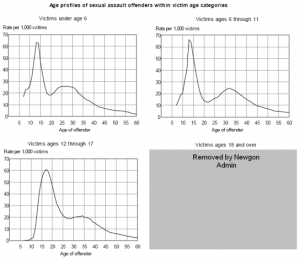Research: Who offends and how often?: Difference between revisions
The Admins (talk | contribs) |
|||
| Line 7: | Line 7: | ||
*'''US Department of Health and Human Services (2006). ''Child Maltreatment 2006'', chapter 3, [http://www.acf.hhs.gov/programs/cb/pubs/cm06/figure3_5.htm Victims by Perpetrator Relationship].''' | *'''US Department of Health and Human Services (2006). ''Child Maltreatment 2006'', chapter 3, [http://www.acf.hhs.gov/programs/cb/pubs/cm06/figure3_5.htm Victims by Perpetrator Relationship].''' | ||
*:82% of child maltreatment (or more) involved a parent. 17% was known to involve a non-parent. | *:82% of child maltreatment (or more) involved a parent. 17% was known to involve a non-parent. | ||
[[Image:Usdojap.PNG|thumb|The peak "perpetrator" activity is at 14-16]]It is worth noting that when the whole population is taken into account, the sexual offender against a minor is very often another minor, ages 14-16 being the peak centre of activity (click to expand). | |||
*'''Howard N. Snyder, Ph.D (2000). [http://www.ojp.usdoj.gov/bjs/pub/pdf/saycrle.pdf ''Sexual Assault of Young Children as Reported to Law Enforcement: Victim, Incident, and Offender Characteristics''], USDOJ/National Center for Juvenile Justice.''' | |||
==How often?== | ==How often?== | ||
Revision as of 14:07, 23 September 2009
 | ||||||||||||
| Part of NewgonWiki's research project | ||||||||||||
|---|---|---|---|---|---|---|---|---|---|---|---|---|
|
| ||||||||||||
| ||||||||||||
|
| ||||||||||||
| Template: Research - This template |
The public discourse on who offends and how often is confused by conflicting mythology. Some private organisations that market CSA products towards parents claim that "strangers" are the number one concern when it comes to protecting children from abuse. Government statistics, human rights and sex offender groups paint a different picture. This has been picked up by political opportunists who use the new data to support the equally flawed myth that everybody is a considerable threat to children.
Who offends?
The statistics do appear to indicate that most child abuse is perpetrated by parents. In fact, if exposure times are to be taken into consideration, it may even be the case that parents have an abnormal tendency to abuse or have sex with their children.
- US Department of Health and Human Services (2006). Child Maltreatment 2006, chapter 3, Victims by Perpetrator Relationship.
- 82% of child maltreatment (or more) involved a parent. 17% was known to involve a non-parent.

It is worth noting that when the whole population is taken into account, the sexual offender against a minor is very often another minor, ages 14-16 being the peak centre of activity (click to expand).
- Howard N. Snyder, Ph.D (2000). Sexual Assault of Young Children as Reported to Law Enforcement: Victim, Incident, and Offender Characteristics, USDOJ/National Center for Juvenile Justice.
How often?
The actual prevalence of abusive sexual behaviours with children has been exaggerated by overbroad definitions.
- Haugaard, J.J. (2000). "The challenge of defining child sexual abuse," American Psychologist, 55(9), 1036-1039.
- "For example, some researchers have considered children to be those below the age of 18 (Russell, 1983; Wyatt, 1985), those below the age of 17 (Finkelhor, 1979; Fromuth, 1986), or those below the age of 16 (Wurr & Partridge, 1996). In addition, defining the term sexual behavior has been difficult. Although some behaviors are considered sexual by almost everyone (e.g., intercourse, genital fondling), there is less agreement about other behaviors, such as bathing children or sleeping with them. Finally, controversy also exists about the meaning of the word abuse. Some have argued that abuse, as used in scientific research, indicates the presence of harm (Rind, Tromovitch, & Bauserman, 1998) and that, consequently, child sexual abuse may not be an appropriate term to describe adult–child sexual encounters from which no demonstrable harm can be observed. [...] First, studies have reported higher prevalence rates with broad definitions than they would have with more restricted definitions. For example, some studies with community samples have reported that as many as 50%–60% of girls are sexually abused by an adult before the age of 18 (Russell, 1983; Wyatt, 1985). These high rates raised public concern about child sexual abuse, and this increased concern may have resulted in many abused children and their families receiving services that might not have been available otherwise."
- World Health Organization (1986). "Child sexual abuse: report on a consultation, Copenhagen, 11-12 December 1985."
- "In all studies most of the cases are single incidents of indecent exposure, propositions to do something sexual which are rejected by the child, and brief genital touching. Offenses involving some degree of force or prolonged or repeated abuse by the same person have been experienced by about one percent of the populations studied."